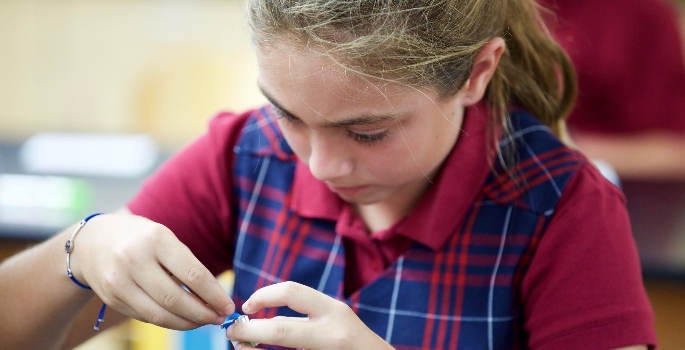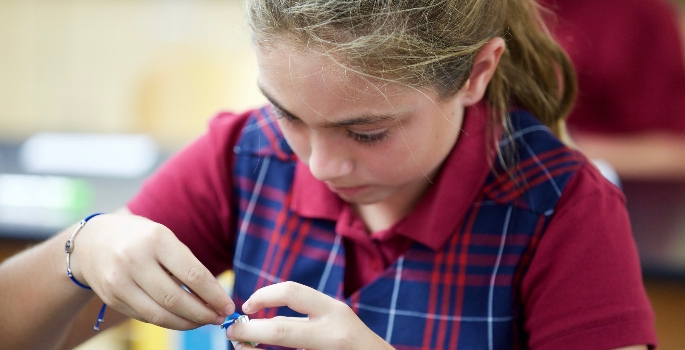At the St. Raymond school in Menlo Park, California, Ken Hawthorn has one
goal: ensure that his school is a model for STEAM learning. Ken is a mechanical engineer turned teacher. As a consulting engineer he worked on a wide range of designs – from electric motorcycles to Large-Scale Processor Reference (LSPR) machines and he holds US Patent 7,713,154 for a Fixed Pitch Continuously Variable Transmission. Today, he applies his passion for engineering to his students at the St. Raymond school and his fellow teachers around the country. Ken recently chose pi-top systems for his classroom and his professional development work.
St. Raymond school is a small, tight-knit community with high-achieving students.
Ken integrates STEAM learning into all of his classroom work where students learn about computer hardware, design, coding in multiple languages, 3-D printing and
are given challenging tasks to complete individually and in teams.
Ken gives his students the following analogy: if you are launching a satellite into orbit, you have a fixed space for the payload, that might be 10cm cubed. With that same idea of mechanical constraints on an electronics system, he asks his students to design a module of their own for the pi-top that will fit in a limited space and serve a new function - like a micro:bit rover or analogue input device.

“What would you want it to do?” he asks. “What would it be used for? OK, now let’s
design it.” And they do, using pi-top systems. Ken’s students learn how to code, design modules, simulate their function, and, often, construct devices using a 3-D printer.
“The pi-top systems allow my students to learn the inner workings of a computer, to
create, design and explore. pi-top provides a classroom-friendly physical chassis for
students to design modules and provides structure when learning code with pi-topOS:
Polaris. The pi-top design enables amazingly easy connections to external hardware and
prototyping components and gives students and teachers the confidence to explore a
computer from the inside out.”
To integrate the pi-top systems into the classroom, Ken first introduces the students
to their pi-top system so they can “get to know them,” as he describes it. “Step two is:
what’s your dream? Now let’s build it.” The result: 300 modules designed by students
from 1st grade through 8th grade, and a school filled with inspired students.
But Ken’s – and his school’s – vision goes well beyond inspiring students at
St. Raymond’s school. It’s a vision of empowering all teachers to use STEAM
learning in their classrooms. Ken leads a number of professional development
programs on campus and at industry events, helping give teachers knowledge
and confidence about using technology in creative, innovative ways. He brings pi-top
systems along to demonstrate new ideas for classroom learning.
Recently, St. Raymond’s school hosted technology and STEM/STEAM teachers from around the San Francisco area for a day of connecting software programs written in
Python to the physical world. They explored code that changed the physical world,
writing Python to turn on LED lights on a breadboard, for example. The teachers gained
valuable knowledge and skills to share with their students.
“The goal is to change the teacher culture so they are comfortable with technology
and employing STEAM,” Ken says. “If I can get each teacher to take back just one
tool to their classroom, the day has been a success.”

Kenneth Hawthorn is a Mechanical Engineer turned teacher. He currently heads the Mechatronics program at St. Raymond school www.straymond.club (blog). The program is cross-curricular and blends the domains of hardware, software and chassis design within the context of Design Thinking. His students become familiar with a wide variety of tools within each of the domains in order to explore the idea of Technology Generalist. Mr. Hawthorn in on the national Teacher Advisory Council for Autodesk and is one of ten 2016/2017 Dremel Idea Builder Ambassadors.
This article was first published in 'Learning by Making' magazine Issue 1.
If you’d like to find out more about how 'learning by making’ with pi-top can help you, your students and your school, get in touch here.
